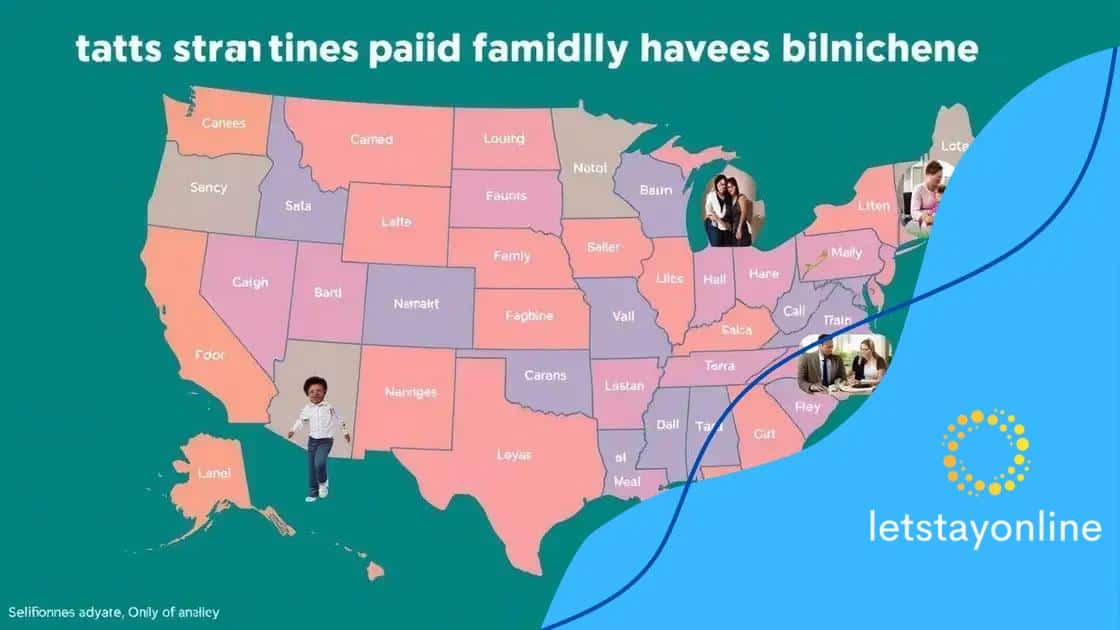The future of paid family leave policies in the US

The future of paid family leave policies in the US includes expanded coverage, federal legislation efforts, and greater public awareness, aiming to provide better support for families balancing work and caregiving responsibilities.
The future of paid family leave policies in the US is a topic that affects many families and workers. Have you ever wondered how these policies can change lives and workplaces? Let’s explore the potential transformations.
Overview of current paid family leave policies
Understanding the current paid family leave policies in the US is essential for families and employers alike. As society evolves, so do the needs for support during times of family crisis or joy.
Key Features of Current Policies
Currently, paid family leave varies significantly from state to state. Some states have robust policies, while others offer little to no support. Key features to consider include:
- Duration: How long can families take leave?
- Payment Rates: What percentage of salary is covered during leave?
- Eligibility Criteria: Who qualifies for these benefits?
- Job Protection: Are employees guaranteed their position upon return?
These factors can deeply impact how families experience maternity and paternity leave. In states like California, employees can take up to 12 weeks of paid leave. This is crucial for new parents to bond with their children without the stress of lost income. However, not all states offer such benefits, leading to disparities across the country.
Impact of State Policies
The variation in policies leads to different outcomes for families. For instance, states with comprehensive paid family leave legislation often see higher job satisfaction and improved mental health among parents. This can lead to better developmental outcomes for children.
On the other hand, in states with minimal or no paid leave, parents may face financial stress, which can affect their family dynamics. This highlights the need for increased awareness and advocacy for better policies.
As the conversation around paid family leave continues to grow, it’s important to monitor legislative changes that may affect future workers and families. Communities are starting to support these changes, and it’s crucial for everyone to stay informed.
Impact of paid family leave on family well-being
The impact of paid family leave on family well-being is profound. When parents have the opportunity to take time off, they can better support their family’s needs during critical times.
Emotional Benefits
Paid family leave can lead to improved emotional health for both parents and children. When parents stay home during important milestones, such as the birth of a child, they experience reduced stress and anxiety.
- Bonding time: Building strong relationships with children early on is crucial for emotional development.
- Parental peace of mind: Parents feel secure knowing they can care for their family without financial pressure.
- Better mental health: Families report higher satisfaction and lower instances of depression.
These emotional benefits contribute to stronger family units. When parents take the time they need, the entire household flourishes.
Financial Stability
Additionally, paid family leave positively affects financial stability. Families who can take leave without fearing loss of income are less likely to face economic hardships.
Staying financially secure results in overall better health as families can prioritize care without the additional worry of bills. This support enables families to focus more on their children and household well-being.
In conclusion, it’s evident that access to paid family leave can enhance a family’s quality of life, leading to happier, more stable environments for children to grow up in.
Comparative analysis of states with paid leave

A comparative analysis of states with paid leave reveals significant differences in policy frameworks and benefits. Understanding these variations helps to illustrate the broader implications for families and employers across the United States.
Top States for Paid Leave
Some states have implemented progressive policies that support families well. States like California, New Jersey, and New York are often highlighted for their strong paid family leave programs. These states provide:
- Extended Leave Duration: Many offer up to 12 weeks of paid leave.
- Generous Payments: These states provide a percentage of the employee’s salary, often covering over 60% of income during leave.
- Inclusivity: Many policies cover a range of family situations, including adoption and foster care.
The success of these programs has led other states to consider similar policies. For example, Washington has made significant strides in implementing a system that supports families through comprehensive paid leave.
Challenges Faced by States
Despite the progress, challenges exist. Some states either lack paid leave policies or have very limited coverage. States without these benefits often experience higher levels of parental stress and financial difficulty during family transitions.
In contrast, regions that embrace paid leave often witness improved mental health outcomes for parents and children alike. States with no paid leave frequently see disparities in family well-being and workforce productivity. Advocates argue that national standards could bridge these gaps and push toward more universal paid family leave options.
By studying these variances, it’s clear that policies not only impact individual families but also reflect broader social values around support and care in the workplace.
Challenges in implementing paid family leave
The challenges in implementing paid family leave are significant and complex. Even though the benefits are clear, many states and employers face barriers when trying to put these policies into practice.
Financial Constraints
One major challenge is the financial burden associated with offering paid leave. Companies often worry about the costs involved in funding such programs. Small businesses, in particular, may find it difficult to manage the expense of retaining employees while also providing paid leave. This can lead to hesitation in adopting these policies.
- Budget limitations: Many businesses operate on tight budgets, making it hard to allocate funds for employee benefits.
- Competitive disadvantage: Employers fear that if they offer paid leave, they may be at a disadvantage compared to competitors that do not.
- Economic variability: Economic downturns can intensify cost concerns, leading to a reduction in benefits.
These financial challenges often result in a lack of comprehensive paid leave policies in various industries.
Regulatory Hurdles
In addition to financial issues, regulatory hurdles complicate the implementation of paid family leave policies. Different states have different laws, making it hard for companies operating in multiple regions to standardize their benefits.
Compliance with varying state regulations can be cumbersome. Employers must navigate the complexities of legislation that differs in duration, payment, and eligibility. This often leads to confusion among both employers and employees.
Furthermore, there is a lack of awareness and understanding of how essential paid family leave is among policymakers. Without strong advocacy for these policies, changes are slow to come. This can result in stagnation, preventing the implementation of necessary reforms.
Overall, addressing these challenges requires collaboration between businesses, government, and community organizations to create a sustainable framework for paid leave that benefits everyone.
Future trends and predictions for paid leave
The future trends and predictions for paid leave in the US indicate a shift towards more inclusive and robust policies. As awareness grows about the benefits of such programs, there are several potential developments on the horizon.
Expansion of Policies
One major trend is the expansion of paid leave policies across more states. Currently, only a handful of states have implemented comprehensive paid family leave programs. However, advocates are pushing for broader adoption. This change is likely to come as more research highlights the positive impacts on both family well-being and workplace productivity.
- Increased State Legislation: More states may introduce or enhance their paid leave laws to attract families and improve their public image.
- Federal Legislation: There are ongoing discussions at the federal level about creating a national paid leave policy, which could standardize benefits across the country.
- Support for Diverse Family Needs: Future policies may also expand to cover a wider range of family situations, including caregiving for aging relatives or support for foster parents.
As the workforce becomes more diverse, the need for adaptability in paid leave policies will become even clearer.
Awareness and Advocacy
Another important trend is the increasing awareness and advocacy for paid family leave. As more people share their personal stories about the need for family leave, public support is likely to grow.
Social media has become a powerful tool for advocacy, creating a platform for discussions around the importance of supportive family policies. This grassroot movement can pressure lawmakers to prioritize paid leave reforms.
Ultimately, these shifts indicate a more supportive environment for workers who balance their jobs and family obligations. Future predictions suggest that as companies begin to see the value in providing these benefits, we may see significant cultural changes around family life.
FAQ – Frequently Asked Questions about Paid Family Leave Policies
What is paid family leave?
Paid family leave is a policy that allows employees to take time off to care for a family member or themselves while receiving partial pay.
How long can I take paid family leave?
The duration of paid family leave varies by state, but many states offer between 6 to 12 weeks of paid leave.
Do all employees qualify for paid family leave?
Eligibility typically depends on the state and employer’s policies, but many require employees to have worked a certain number of hours or months.
How does paid family leave benefit families?
Paid family leave supports families by allowing them to bond with a new child or care for a sick family member without losing income, thus reducing stress and improving well-being.






